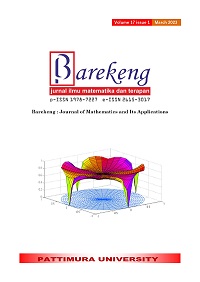THE APPLICATION OF GUMBEL COPULA TO ESTIMATE VALUE AT RISK WITH BACKTESTING IN TELECOMMUNICATION STOCK
Abstract
The Value at Risk (VaR) method refers to a statistical risk measurement tool used to determine the maximum loss of an investment, while the distribution that must be met is the normal distribution. This is not in line with the actual situation, because the distribution of the return value is found to be not normally distributed but depends on market conditions that occurred at that time, thus invalidating the VaR estimate and resulting in greater portfolio risk. Therefore, in this study, the estimation of risk value will be carried out using the Gumbel Copula method which can model the dependency structure between stocks and is flexible enough to model financial return data from https://finance.yahoo.com/. The parameter estimates produced by the Gumbel Copula method are then used to calculate the VaR at 90%, and 99% confidence levels. The resulting VaR values are 0,076 and 0.231. To test the feasibility of the VaR model, backtesting was carried out and concluded that the VaR value obtained was valid and suitable for use in the risk assessment of PT. XL Axiata Tbk and PT. Telkomunikasi Indonesia Tbk.
Downloads
References
U. Zuhara and M. A. Sjahid, "Penggunaan Metode VaR (Value at Risk) dalam Analisis Risiko Investasi Saham dengan Pendekatan Generalized Pareto Distribution (GPD)," JURNAL SAINS DAN SENI ITS, pp. 56-61, 2012.
N. N. Luh and K. Dharmawan, "ESTIMASI NILAI AVERAGE VALUE AT RISK PADA SAHAM PORTOFOLIO DENGAN MENGGUNAKAN METODE ANALISIS KOMPONEN UTAMA," E-Jurnal Matematika, vol. 6, no. 1, pp. 56-64, 2017.
S. Carrillo Menéndez and B. Hassani, "Expected Shortfall Reliability—Added Value of Traditional Statistics and Advanced Artificial Intelligence for Market Risk Measurement Purposes," Mathematics, vol. 9, no. 2142, 2021.
P. Prakash and V. Sangwan, "Transformational Approach to Analytical Value-at-Risk for near Normal Distributions," Journal of Risk and Financial Management, vol. 14, no. 51, 2021.
A. Najiha and Anisa, "Nilai Risiko Terkondisi pada Return Finansial Menggunakan Metode Copula Gumbel," Estimasi, Vol. 3,No. 1,Januari,2022, Hal., vol. 3, pp. 49-58, 2022.
Y. He and J. Deng, "Short-term Power Load Forecasting with Deep Belief Network and Copula Models," 9th International Conference on Intelligent Human-Machine Systems and Cybernetics, pp. 191-194, 2017.
S. Halilbegovic and M. Vehabovic, "Backtesting Value at Risk Forecast: the Case of Kupiec Pof-Test," European Journal of Economic Studies, vol. 17, no. 3, pp. 393-404, 2016.
N. NOLDE and J. F. ZIEGE, "ELICITABILITY AND BACKTESTING: PERSPECTIVES FOR BANKING REGULATION," The Annals of Applied Statistics, vol. 11, p. 1833–1874, 2017.
A. M. Telussa and E. R. Persulessy, "Penerapan Analisis Korelasi Parsial Untuk Menentukan Hubungan Pelaksanaan Fungsi Manajemen Kepegawaian dengan Efektivitas Kerja Pegawai," Barekeng Jurnal Ilmu Matematika dan Terapan, vol. 7, pp. 15-18, 2013.
R. Eko Caraka and H. Yasin, "TIME SERIES ANALYSIS USING COPULA GAUSS AND AR(1)-N.GARCH(1,1)," MEDIA STATISTIKA, vol. 1, no. 9, pp. 01-13, 2016.
H. Hidayati and K. Dharmawan, "ESTIMASI NILAI CONDITIONAL VALUE AT RISK MENGGUNAKAN FUNGSI GAUSSIAN COPULA," E-Jurnal Matematika, vol. 4, pp. 188-194, 2015.
M. Sahamkhadam and A. Stephan, "Portfolio optimization based on GARCH-EVT-Copula forecasting models," International Journal of Forecasting, p. 2018, 497–506.
N. Lestari Arisandi and D. Budi Nugroho, "Analisis Prediksi IHSG Berdasarkan Kurs Beli IDR-USD Melalui Regresi Copula," Jurnal Matematika dan Aplikasi deCartesiaN, vol. 7, p. 59 – 67, 2018.
T. Modarres and R. Modarres, "Data-based analysis of bivariate copula tail dependence for drought duration and severity," HYDROLOGICAL PROCESSES, p. 1454–1463, 2013.
Q. Rara S. and T. Widiharih, "VALUE AT RISK IN STOCK PORTFOLIO USING T-COPULA: Case Study of PT. Indofood Sukses Makmur, Tbk. and Bank Mandiri (Persero), Tbk.," MEDIA STATISTIKA, vol. 2, no. 12, pp. 175-187, 2019.
H. Yasin and S. Suparti, "PEMODELAN VOLATILITAS UNTUK PENGHITUNGAN VALUE AT RISK (VaR) MENGGUNAKAN FEED FORWARD NEURAL NETWORK DAN ALGORITMA GENETIKA," MEDIA STATISTIKA, vol. 7, pp. 53-61, 2014.
D. Maghfiroh Wahyuni and A. Aziz, "Estimasi Parameter Capital Assets Pricing Model Dengan Metode Generalized Method of Moments Dalam Perhitungan Value At Risk," Jurnal Riset Mahasiswa Matematika, vol. 1, no. 1, pp. 32-39, 2021.
O. Shivraj Swami and S. Kumar Pandey, "Value-at-Risk Estimation of Foreign Exchange Rate Risk in India," Asia-Pacific Journal of Management Research and Innovation, vol. 12, no. 1, p. 1–10, 2016.
F. Iorgulescu, "Backtesting value-at-risk: Case study on the Romanian capital market," Procedia - Social and Behavioral Sciences, p. 796 – 800, 2012.
Copyright (c) 2023 Alimatun Najiha, Erna Tri Herdiani, Georgina Maria Tinungki

This work is licensed under a Creative Commons Attribution-ShareAlike 4.0 International License.
Authors who publish with this Journal agree to the following terms:
- Author retain copyright and grant the journal right of first publication with the work simultaneously licensed under a creative commons attribution license that allow others to share the work within an acknowledgement of the work’s authorship and initial publication of this journal.
- Authors are able to enter into separate, additional contractual arrangement for the non-exclusive distribution of the journal’s published version of the work (e.g. acknowledgement of its initial publication in this journal).
- Authors are permitted and encouraged to post their work online (e.g. in institutional repositories or on their websites) prior to and during the submission process, as it can lead to productive exchanges, as well as earlier and greater citation of published works.






1.gif)



